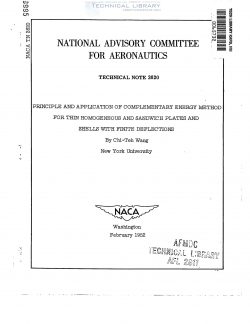naca-tn-2620
- Version
- 51 Downloads
- 841.11 KB File Size
- 1 File Count
- January 9, 2017 Create Date
- January 9, 2017 Last Updated
National Advisory Committee for Aeronautics, Technical Notes - Principle and Application of Complementary Energy Method for Thin Homogeneous and Sandwich Plates and Shells with Finite Deflections

The principle of complementary energy in the nonlinear elasticity
theory is shown to be derivable from the principle of potential energy
by a Legendre type of transformation. In particular, the expression of
the complementary energy is derived for homogeneous and sandwich plates
and shells with large deflections. By the method of complementamy p
energy, the stress-strain relations are derived for homogeneous shells,
sandwich plates, and sandwich shells. Without the use of this method
much lengthier calculations would be necessary.
In the theory of elasticity, the most important variational
principle is perhaps the principle of potential energy, which states
that of all displacements satisfying given boundary conditions those
that satisfy the equilibrium conditions make the potential energy a
stationary value. For stable equilibrium, the stationary value may be
shown to be a minimum (reference 1). The potential energy is defined
as the difference between the strain energy and the potential or virtual
work which the surface stresses do over that portion of the surface on
which the surface stresses are prescribed. This principle is capable of
general application as it holds true no matter what the law connecting
load and deformation may be (reference 2). With the relationships
between stresses, strains, and displacements known, the differential
equations defining the equilibrium conditions may be derived from the
variational principle by the methods of the calculus of variations;
The principle of potential energy was obtained by comparing the
strain energy U of the equilibrium state, characterized by displace—
ments u, v, and w, with the strain energy U + AU of a neighboring
displacement state u + An, v + AN, and w + AM. A corresponding
variational principle may be derived by varying the stresses rather
than the displacements. This results in the so-called principle of
complementary energy which states that of all stress states satisfying
the conditions of equilibrium in the interior and on that portion of
the surface on which the surface forces are prescribed the actual state
of stress is such that the complementary energy is a stationary value.
| File | Action |
|---|---|
| naca-tn-2620 Principle and Application of Complementary Energy Method for Thin Homogeneous and Sandwich Plates and Shellds with.pdf | Download |

Comment On This Post